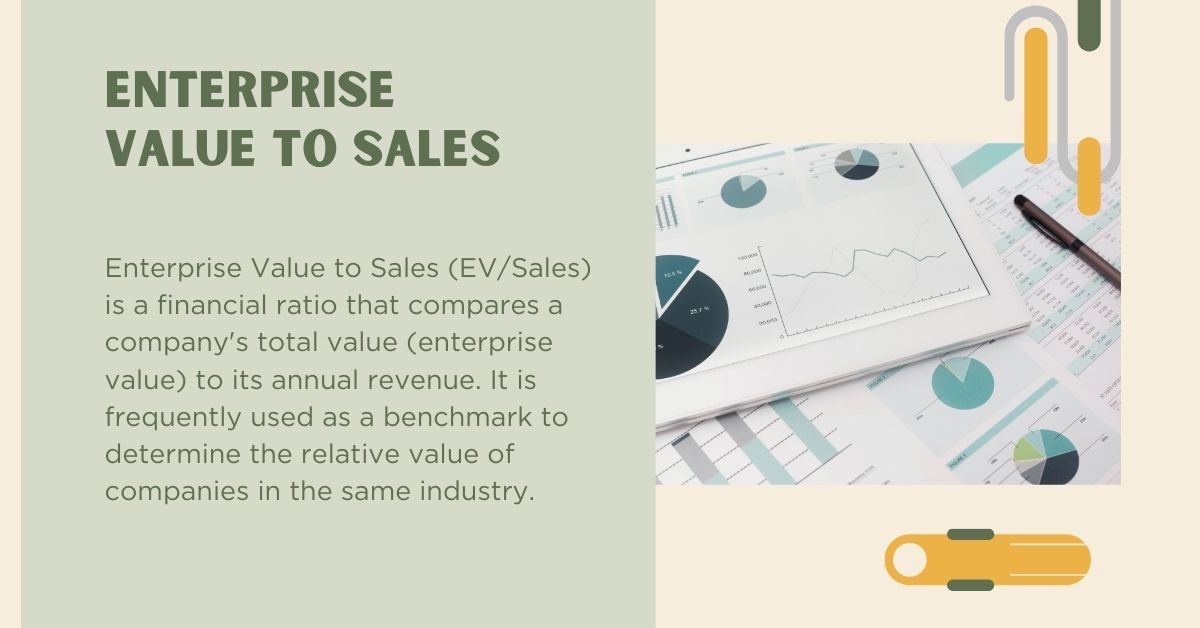To ensure a profitable investment, investors frequently rate a number of variables before purchasing a company’s market shares. They can analyze the enterprise value-to-sales ratio, which is a formula that provides information about a company’s financial health. If you’re looking to make an investment, you may use this equation to figure out which company will generate the most value over time.
In this post, we define enterprise value-to-sales, explain why it is significant, show how to calculate it, and provide a full example of a completed equation for your reference.
What is Enterprise Value to Sales?

Enterprise Value to Sales (EV/Sales) is a financial ratio that compares a company’s total value (enterprise value) to its annual revenue. It is frequently used as a benchmark to determine the relative value of companies in the same industry.
A lower EV/Sales ratio typically indicates that a firm is cheap, whereas a greater ratio may imply that it is overpriced. When assessing this ratio, it is vital to take into account other elements such as growth potential, profitability, and industry-specific trends.
Enterprise Value to Sales Formula
Enterprise Value to Sales (EV/Sales) Formula:
EV/Sales = Enterprise Value / Sales
- Enterprise Value (EV): This is the total market capitalization of a company plus its debt minus its cash. It represents the total value of the company, including both equity and debt.
- Sales: This is the total revenue the business generated over a given time period, typically a year.
In essence, the EV/Sales ratio determines the number of times a company’s annual sales can cover its total enterprise value.
Example of Enterprise Value to Sales
Let’s say Company A has an enterprise value of $100 million and annual sales of $50 million. To calculate the EV/Sales ratio, we would divide the enterprise value by the sales:
EV/Sales = $100 million / $50 million = 2
This means that for every $1 of sales, Company A’s enterprise value is $2.
If the average EV/Sales ratio for companies in Company A’s industry is 3, then Company A might be considered undervalued as its ratio is lower. However, it’s important to note that other factors, such as growth prospects, profitability, and industry-specific trends, should also be considered when analyzing the valuation.
What Does Enterprise Value-to-Sales Tell You?
Enterprise Value-to-Sales (EV/Sales) is a financial ratio that shows how a company’s valuation compares to its revenue-generating. A lower EV/Sales ratio typically indicates that a firm is undervalued, which means that its stock price may be less than its true worth.
Conversely, a greater EV/Sales ratio may imply that the company is overpriced. When assessing this ratio, it is vital to take into account other elements such as growth potential, profitability, and industry-specific trends. Essentially, EV/Sales aids investors in determining whether a company’s stock price is reasonable given its capacity for generating revenue.
EV Sales Vs. PS
| Feature | EV/Sales | P/S |
|---|---|---|
| Calculation | Enterprise Value / Sales | Price per Share / Sales per Share |
| Focus | Company’s overall value relative to its revenue | Stock price relative to the company’s revenue |
| Includes | Debt, cash, preferred stock | Only common stock |
| Valuation perspective | Enterprise level | Shareholder level |
| Usefulness | Comparing companies across industries, considering capital structure | Assessing the relative valuation of a company’s common stock |
Want to read more about to P/S ratio, you can read: Price to Sales: A Guide to Valuing Stocks Based on Revenue
Advantages and Disadvantages of Enterprise Value to Sales
| Advantage | Disadvantage |
|---|---|
| Industry-neutral: Can compare companies across different industries, regardless of capital structure. | Sensitive to cyclical industries: In cyclical industries, revenue fluctuations can significantly impact the EV/Sales ratio. |
| Focuses on fundamentals: Emphasizes the company’s core business and revenue generation. | Doesn’t consider profitability: Doesn’t account for a company’s profitability or operating expenses. |
| Simple to calculate: Easy to understand and calculate. | Can be misleading for companies with negative earnings: A negative EV/Sales ratio can be misleading for companies with negative earnings. |
| Useful for identifying undervalued companies: A low EV/Sales ratio can signal a potential undervaluation. | Doesn’t account for growth potential: Doesn’t consider future growth prospects or opportunities. |
What Are the Applications of Ev-to-sales Ratio?
The EV-to-Sales ratio has a number of applications in financial analysis:
- Company valuation is a commonly used tool for evaluating the valuations of firms in the same industry or area. A lower EV/Sales ratio may indicate that a company is cheap relative to its peers.
- Industry Benchmarking: By comparing a company’s EV/Sales ratio to the industry average, investors can determine if it trades at a premium or discount.
- Mergers and Acquisitions: The EV/Sales ratio can be used to assess possible merger or acquisition targets. A lower EV/Sales ratio for the target company could signal a more appealing purchase price.
- Investors can use the EV/Sales ratio to uncover undervalued companies. However, it is critical to evaluate other elements, such as growth possibilities and profitability.
- Assessing cyclical industries: The EV/Sales ratio is especially effective for studying cyclical businesses since it focuses on revenue rather than profitability, which can vary greatly in these sectors.
Which is better, EV-to-EBITDA or EV-to-Sales?
The decision between EV-to-EBITDA and EV-to-Sales is determined by the specific circumstances and analytical goals.
EV-to-EBITDA is often recommended for companies with major capital expenditures or depreciation expenses because it prioritizes operating earnings above these non-cash charges. This can provide a more accurate picture of a company’s underlying profitability.
EV-to-Sales is better suited for companies with a high amount of debt or preferred stock because it considers the complete capital structure in its value. It is particularly beneficial for comparing organizations across industries because it is less affected by accounting variations.
Finally, the optimal ratio is determined by the individual characteristics of the companies under consideration as well as the analysis’s aims. In many circumstances, combining these ratios with additional valuation indicators can provide a more complete view of a company’s value.
What is a Good Enterprise Value to Sales Ratio?
A “good” Enterprise Value to Sales (EV/Sales) ratio is determined by a variety of criteria, including industry, firm size, growth prospects, and general market circumstances.
A lower EV/Sales ratio typically indicates that a firm is undervalued, which means that its stock price may be lower than its true worth. However, an extremely low ratio may signal that the organization is facing major issues or that its growth opportunities are limited.
Conversely, a greater EV/Sales ratio may indicate that the company is overpriced. However, a high ratio may be justified if the company has good growth prospects, large profit margins, or operates in a rapidly growing industry.

